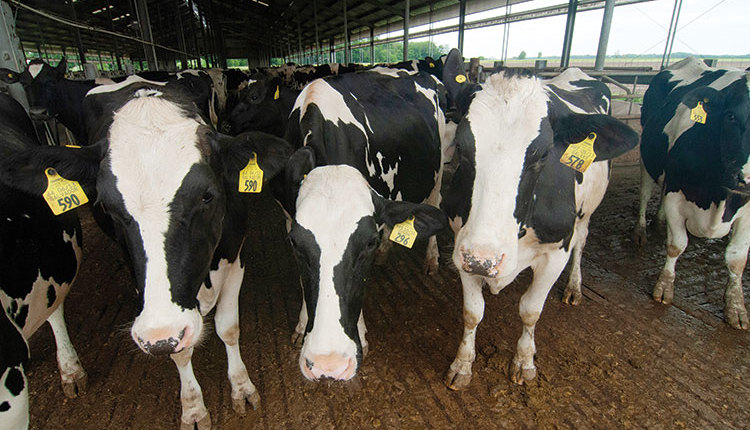The author is professor of animal sciences at Kansas State University, Manhattan.
Dairy producers who achieve reasonably good pregnancy rates can always benefit from improved heat detection. Even for those who apply timed A.I. protocols to program ovulation before first or repeat inseminations can find value from good heat detection. Boosting heat detection rates by 10 to 20 percentage points could be invaluable to increasing your herd's pregnancy rates.
Traditional heat detection methods involve visual observation of sexual-related behavior displayed by cows. Accuracy of visual observation varies according to the expertise of herd personnel, frequency of observation, housing and footing conditions, and milk production levels. The challenge of an excellent heat detection program is not only correctly identifying estrus (accuracy), but also not missing any displayed heat activity (efficiency). Generally, well-trained herd personnel are quite accurate identifying cows in heat, but lack of efficiency of observing all possible cows in heat is the limiting factor. According to DRMS Dairy Metrics, average heat detection rate is only 51 percent in more than 6,800 U.S. Holstein herds analyzed.
Multiple options exist
As a result of the inefficiency of visual observation, several types of detection aids were created:
Electronic mounting sensors (such as HeatWatch or Tattle Tale) applied to the cow are activated by a mounting herdmate. Accuracy and efficiency of these systems are quite high because they are associated with specific heat behavior and they are on the job 24 hours per day. The downside to these systems is the labor associated with applying the sensor patches and the maintenance to keep sensor patches affixed to cows until pregnancy occurs.
In the 1980s, pedometers were first introduced to the dairy industry. Pedometers affixed to the leg quantitate or estimate cow movement by counting the number of steps taken by the cow. More physical activity by the cow provides 70 to 80 percent accuracy in heat detection. Charles Kiddy reported that cows housed in free stalls were approximately 2.75 times more active during estrus than when not in estrus. Further, relatively little within-cow variation in activity occurred from day to day when cows were not in heat. Therefore, activity monitors could be excellent predictors of sexual behavior associated with estrus.
The latest version of electronic heat detection aids that appeared in the early part of this decade were the neck-mounted activity tags containing a microprocessor and a three-dimensional accelerometer. The accelerometer allows accurate measurement of cow movement. The activity tag monitors specific heat-related movement and its intensity, resulting in heat detection accuracies of 90 to 95 percent. By 2010, the Heatime product marketed by a number of companies worldwide became the best-selling system in the world with about a million heat detection tags sold, proving that dairy farmers were willing to invest in technologies that provide a real solution to heat detection.
A number of similar activity tags are available on the market (DeLaval's ALPRO, Bou-Matic's CowTrakker, Select Sire's Select Detect, or Dairymaster's Moo-Monitor). These systems are effective management tools in the A.I. program because they increase heat detection rates. Increasing heat detection rates result in higher A.I. submission rates and more potential pregnancies.
It is clear that these new technological solutions for heat detection are more effective than heat mount detectors, tail paint, or tail chalk. Adoption rates for these technologies has been rather slow, but their rate of adoption is growing as they become more accurate and dependable. Awareness of the existence of such new technological solutions will lead to their widespread use on dairy farms.
Click here to return to the Reproduction E-Sources 110110_28
Dairy producers who achieve reasonably good pregnancy rates can always benefit from improved heat detection. Even for those who apply timed A.I. protocols to program ovulation before first or repeat inseminations can find value from good heat detection. Boosting heat detection rates by 10 to 20 percentage points could be invaluable to increasing your herd's pregnancy rates.
Traditional heat detection methods involve visual observation of sexual-related behavior displayed by cows. Accuracy of visual observation varies according to the expertise of herd personnel, frequency of observation, housing and footing conditions, and milk production levels. The challenge of an excellent heat detection program is not only correctly identifying estrus (accuracy), but also not missing any displayed heat activity (efficiency). Generally, well-trained herd personnel are quite accurate identifying cows in heat, but lack of efficiency of observing all possible cows in heat is the limiting factor. According to DRMS Dairy Metrics, average heat detection rate is only 51 percent in more than 6,800 U.S. Holstein herds analyzed.
Multiple options exist
As a result of the inefficiency of visual observation, several types of detection aids were created:
- Heat mount patches, tail chalk, or tail paint that are activated or rubbed off when a cow in heat has been mounted
- Mounting sensors that indicate that a cow in heat has been mounted
- Monitors that measure higher physical activity generally correlated with heat activity
Electronic mounting sensors (such as HeatWatch or Tattle Tale) applied to the cow are activated by a mounting herdmate. Accuracy and efficiency of these systems are quite high because they are associated with specific heat behavior and they are on the job 24 hours per day. The downside to these systems is the labor associated with applying the sensor patches and the maintenance to keep sensor patches affixed to cows until pregnancy occurs.
In the 1980s, pedometers were first introduced to the dairy industry. Pedometers affixed to the leg quantitate or estimate cow movement by counting the number of steps taken by the cow. More physical activity by the cow provides 70 to 80 percent accuracy in heat detection. Charles Kiddy reported that cows housed in free stalls were approximately 2.75 times more active during estrus than when not in estrus. Further, relatively little within-cow variation in activity occurred from day to day when cows were not in heat. Therefore, activity monitors could be excellent predictors of sexual behavior associated with estrus.
The latest version of electronic heat detection aids that appeared in the early part of this decade were the neck-mounted activity tags containing a microprocessor and a three-dimensional accelerometer. The accelerometer allows accurate measurement of cow movement. The activity tag monitors specific heat-related movement and its intensity, resulting in heat detection accuracies of 90 to 95 percent. By 2010, the Heatime product marketed by a number of companies worldwide became the best-selling system in the world with about a million heat detection tags sold, proving that dairy farmers were willing to invest in technologies that provide a real solution to heat detection.
A number of similar activity tags are available on the market (DeLaval's ALPRO, Bou-Matic's CowTrakker, Select Sire's Select Detect, or Dairymaster's Moo-Monitor). These systems are effective management tools in the A.I. program because they increase heat detection rates. Increasing heat detection rates result in higher A.I. submission rates and more potential pregnancies.
It is clear that these new technological solutions for heat detection are more effective than heat mount detectors, tail paint, or tail chalk. Adoption rates for these technologies has been rather slow, but their rate of adoption is growing as they become more accurate and dependable. Awareness of the existence of such new technological solutions will lead to their widespread use on dairy farms.










